Cite this document
(“The role of supply chain management in tourism Research Paper”, n.d.)
Retrieved de https://studentshare.org/tourism/1391047-the-role-of-supply-chain-management-in-tourism
Retrieved de https://studentshare.org/tourism/1391047-the-role-of-supply-chain-management-in-tourism
(The Role of Supply Chain Management in Tourism Research Paper)
https://studentshare.org/tourism/1391047-the-role-of-supply-chain-management-in-tourism.
https://studentshare.org/tourism/1391047-the-role-of-supply-chain-management-in-tourism.
“The Role of Supply Chain Management in Tourism Research Paper”, n.d. https://studentshare.org/tourism/1391047-the-role-of-supply-chain-management-in-tourism.


